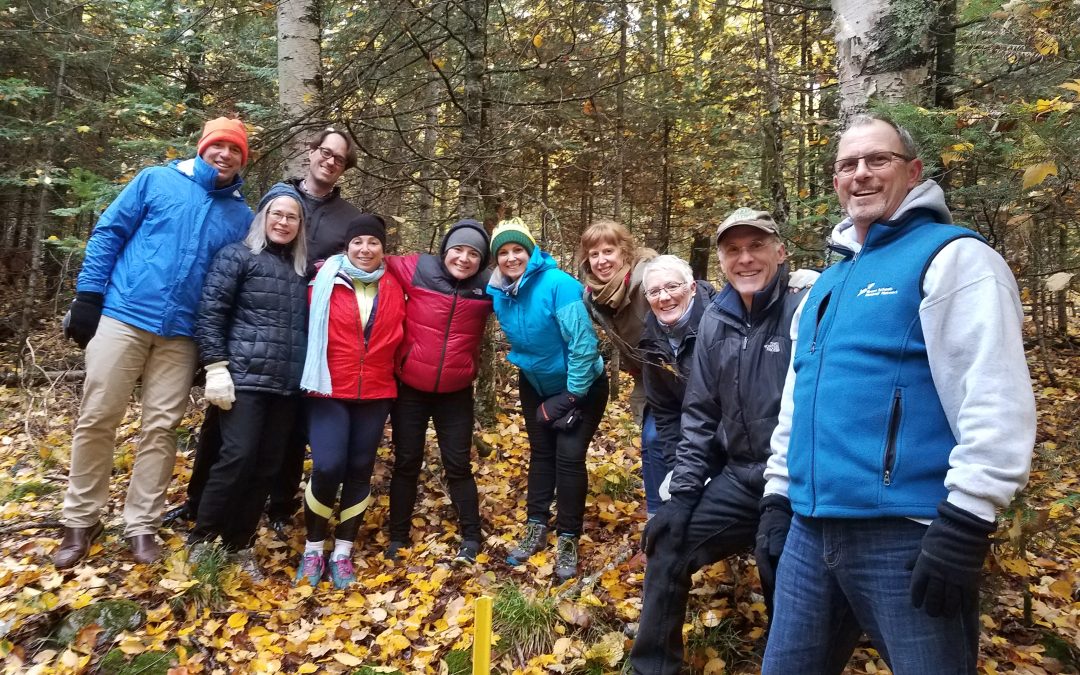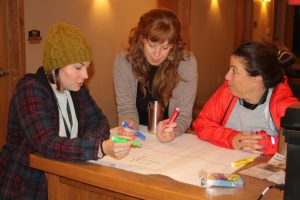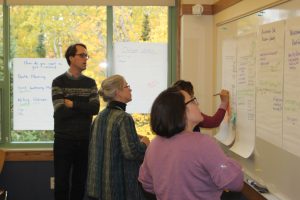By. Tina Nilsen-Hodges
It’s day one of the first-ever Green Schools Catalyst Leaders Fall Summit at Conserve School in Land O’Lakes, Wisconsin. A cold October rain is pelting my umbrella as I gingerly position my sit-upon just off the forest trail. Clutching my notebook with a hand warmed by a hand-knitted glove, I was admittedly skeptical that I could sustain focus on a plant for 15 minutes. However, the activity invited my curiosity in a plant I recognized from many hikes in the woods near my home in upstate New York, one that also seems to be familiar in these northern Wisconsin woods. Under the dripping canopy I begin to look, seeing this plant as if for the first time.
There was a deeper purpose behind my observations of this plant. My fellow Catalyst Leaders and I were challenged to think about how we could shift paradigms in our schools by learning FROM nature to solve problems rather than simply learning ABOUT nature as a subject – and to apply that learning to our own development as a network of schools with the big, audacious goal of a green, healthy school for all children by 2040. Our first day together was designed to explore the concept of “generous ecosystems” with Sherry Ritter of the Biomimicry Institute. Building on that concept, we were invited to consider what nature teaches us about networks, and how we could use that learning to grow our budding Catalyst Schools and Districts Network in a way that would serve as a generative model for other schools. On this day, that meant venturing outside in a downpour! And so we did.
Many miles away from home, I felt a kinship with this little plant I recognized but couldn’t identify, one of many of its type creating a low groundcover of small plants that looked like a cross between a miniature pine and a cactus. Settling into my spot, I soon experienced the thrill of discovery as I explored: this was not many plants of the same type – this was one plant! I pulled off my gloves to feel the trail of the runners among the leaf debris, seeing the tender tendrils reaching to anchor it into the ground, finding no point of disconnect. If there was more than one plant here, I couldn’t distinguish among them. I stood to get a better perspective and saw not many but one plant reaching out in every direction.
I am deeply honored for New Roots Charter School to be recognized as a Catalyst Leader with learning to offer other schools. At our very first gathering at the 2017 Green Schools Conference and Expo, my big takeaway was recognizing the potential for this network to serve as a catalyst for growth and development within our school and the capacity for each of the Catalyst Schools and Districts to be stronger and better together. I understood that preparing to serve as a resource for other schools will help our staff focus and develop our own practices, enhancing and deepening the learning opportunities we offer our students. I saw and experienced this transformative impact myself at our fall retreat at Conserve School.
Bringing together a small, diverse group of school leaders and teachers, Green Schools National Network (GSNN) Executive Director Jenny Seydel led us through a process to explore our common ground and identify what we have to offer other schools, to share resources, to receive support and inspiration from peers on key issues, and to create a vision to guide our own professional path and our growing network. We built on the conceptual understanding about how to tap into the “genius of place” and discern nature’s unifying patterns, developed on day one with Jenny and GSNN’s Director of Innovative Learning David DenHartog, which facilitated a process to bring our own “genius of place” to the network and develop a vision for how our network could serve as a catalyst for our learning and growth.
Our learning was sparked by the shared experience of observing an environmental science class that integrated studies of climate change with time in nature and an art class that called us outside to gather fall leaves for printmaking. We then reflected on our observations and learning experiences through the lens of a best practices rubric developed by teachers and school leaders at Environmental Charter Schools in Los Angeles, California. The rubric provided a focused lens for us to study and name shared best practices that characterize our schools – small learning communities, interdisciplinary curriculum and authentic assessment, relevant and engaging instruction, environmental and experiential learning, and collaboration with partners – and gave us a practical tool to take back to our schools. Other highlights of this time included an opportunity to receive feedback on a problem of practice we were grappling with and to co-create a vision of how the Catalyst Schools and Districts Network could be a resource to us as we developed our capacity to be a resource for other schools. On our final day together, we participated in a visioning activity that called on us to vividly imagine and express where we wanted to be in one year’s time.
My own learning through this process was powerful, but the most inspiring experience from this retreat was seeing New Roots teacher Audrey Southern light up like those brilliant golden leaves when the sun peeked through. Serving as our grade 11-12 social studies teacher since our second year, Audrey has evolved naturally into a leadership role at New Roots, facilitating our upper school team and assuming growing responsibility for our senior year program and curriculum leadership. I was thrilled to see Audrey fully engaged and contributing the critical perspective that only a teacher can bring to the dialogue, enriching our shared understandings while deepening her own, seeing herself in a new light in the process. Sharing this experience, we also strengthened our professional relationship in ways that enhance our ability to collaborate in bringing the network’s resources back into our own school.
These powerful outcomes were no happy accident. This was the wisdom of our masterful and experienced GSNN facilitators at play, using time-honored practices and protocols to maximize meaning, connection, and synthesis at a pace that was simultaneously comfortable and on the move. We experienced the power of a variety of protocols and left the retreat with an abundance of well-organized resources to bring back to our schools. There is no waste in nature; we experienced that concept vividly at the fall retreat, every moment purposeful without being rushed.
As I wake this morning and stretch toward the light, I imagine the presence of our network around me, like the living community of lycopodium in the woods at Conserve School. Contemplating the day’s challenges, I draw strength and inspiration from our shared connections and roots. I see the seed pods thrust upward to the wind. I see runners exploring in all directions. And I know that a green, healthy school for ALL children is possible, thanks to the generative power of our network. Thank you, GSNN!
Author Bio
Tina Nilsen-Hodges led the founding team of New Roots Charter School and has served as head of school since the school opened in 2009. Certified as a NYS K-12 teacher, school building, and district leader, Tina taught in independent, progressive, and Montessori schools and programs for nearly two decades before moving to EcoVillage at Ithaca in 2002 seeking a community interested in starting a school focused on education for sustainability. A lifelong resident of upstate New York, Tina is passionate about the opportunities that education for sustainability offers to unlock the powerful and unique human potential of every student.



